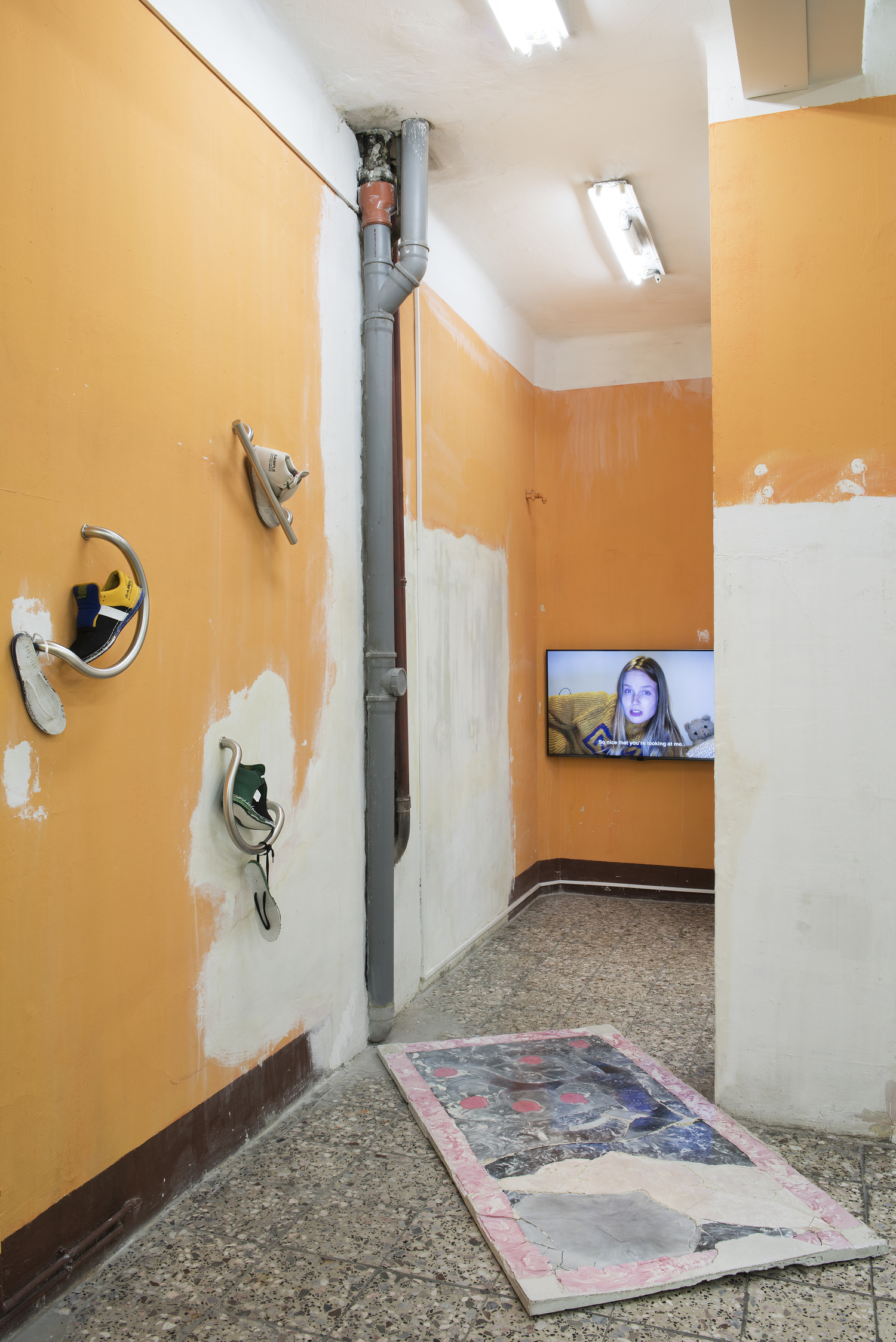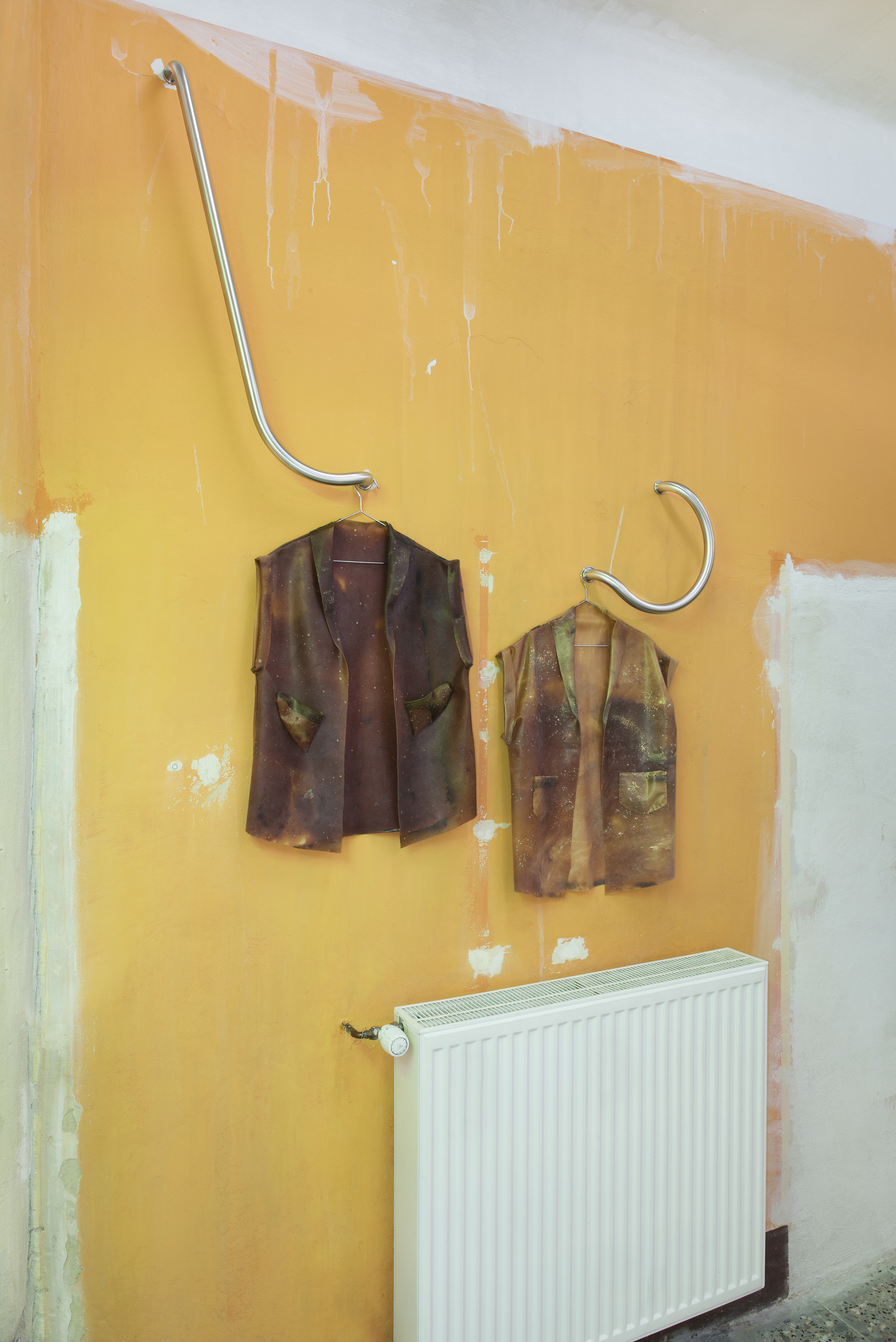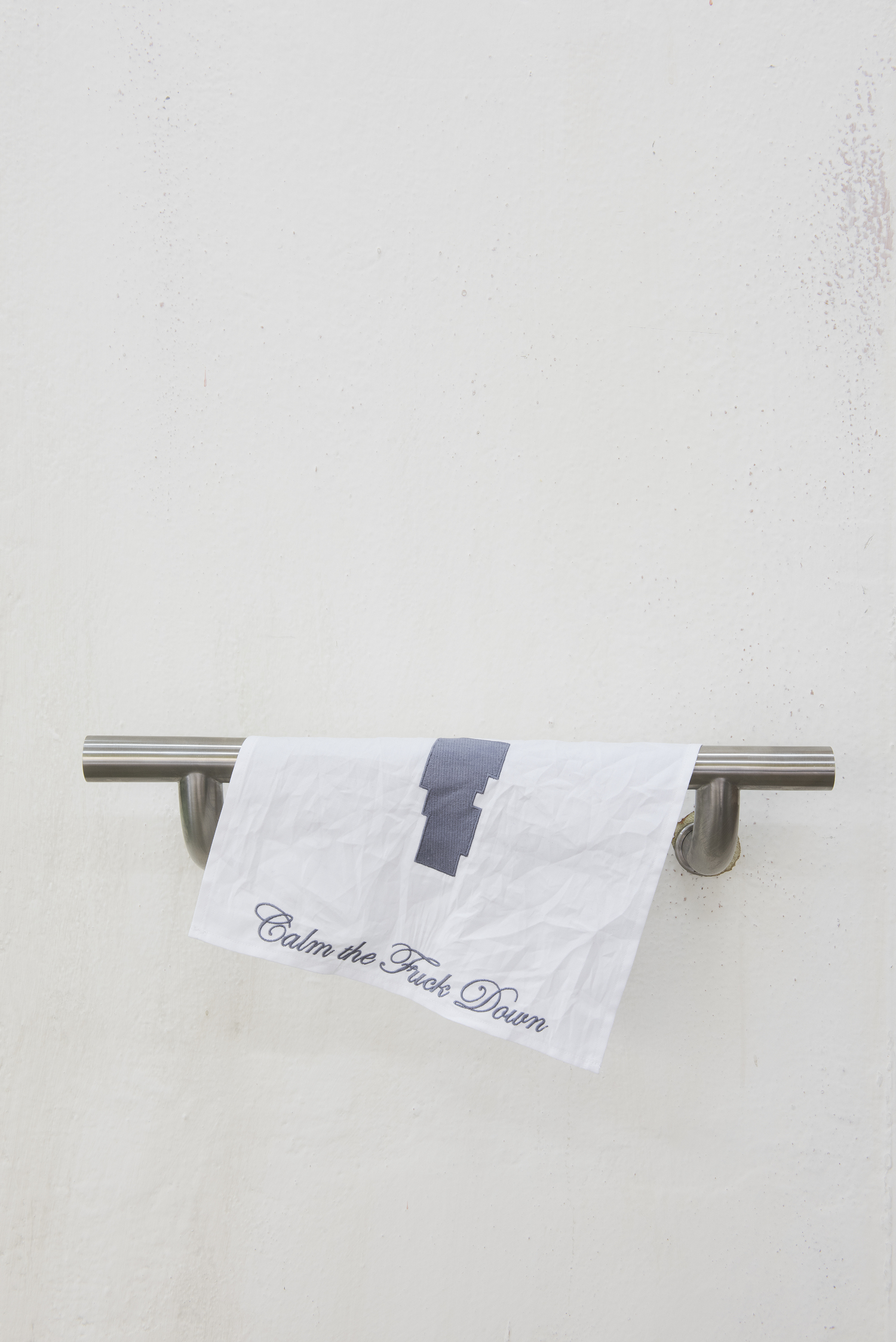
Preparatory Portrait of a Young-Girl
PLATO Office for Art, Ostrava, Czech Republic
16. 3. – 7. 5. 2017
Artists: Melissa S Armstrong, Bianca Bondi, Zuzanna Czebatul, Roderick Hietbrink, Lukáš Hofmann / Saliva, Elisa van Joolen, Martin Kohout, Aditya Mandayam, Justin Morin, Jaakko Pallasvuo & Anni Puolakka, Scheltens & Abbenes, Ania Shestakova, Adéla Součková, Aleksandra Ska
Curated by Daniela&Linda Dostálková, Michal Novotný

PLATO Office for Art, Ostrava, 2017

Scheltens&Abbenes, Vitrineposter, 2010

PLATO Office for Art, Ostrava, 2017
The exhibition Preparatory Portrait of a Young-Girl is a teaser, a condensed montage of moments that, in the future, might tell the story of a newly emerging institution. On a limited scale, it attempts to show several attitudes and approaches to art within a format different from that of the traditional exhibition, spread in time and space and intended purely for contemplation or rationalization.
As much as possible, the space of the Office for art has been left in its original condition, not attempting to cover up its history and initial use; on the contrary, the forgotten layers of its previous life are archaeologically uncovered and emphasized. The space itself thus becomes the first exhibit on show. Individual activities as well – the everyday work of the staff, exhibition activity, accompanying and educative programmes, as well as live events – will not be separated in the architecture and will freely mingle throughout the entire space.
Reacting in their character to the previous use of the space as a textile shop, the selected works create a sort of dreamy, unclearly determined space. While some of the art here merges with the existing environment, other items complement it and the whole is meant to awaken curiosity and amazement in random passers-by looking through the shop-window. As to the items on exhibit, visual art is next to fashion and design, and fiction as well as specialist literature are included in the exhibition. Some of the exhibited items belong to mutiples series and are available for purchase, just like the books.
The material part of the exhibition will later be complemented with a series of events expanding the extent of the exhibition beyond the space of the office itself: the performance series held on 12 April on the premises of the former Bauhaus will reflect on the surrounding urban environment and on specific interventions within it.
The exhibition title refers to the book Raw Materials for a Theory of the Young-Girl, published in 1999 by a group of theorists around the French philosophical journal Tiqqun. It describes the figure of the Young-Girl as simultaneously one of the most important archetypes and marketing mechanisms of contemporary culture. Representing a set of moral and sentimental values celebrated in film and music, the Young-Girl at the same time also stands for their solid connection to commercial strategies of capital firms that use the association of youth and sexuality to link social attitudes with the consumption of specific products.
On a further level of perception, the exhibited works are a kind of material equipment, a necessary set of products representing, in the manner of glossy magazines, must-haves (or at least must-knows) for the Young-Girl, since her existence as a Young-Girl is affirmed specifically by selection and consumption. In another dimension, then, the exhibition constitues a set of aesthetic and conceptual strategies by which artists critically approach the metaphor of fashion, but which at the same time create a certain canon of contemporary art.

Martin Kohout, Dreadlocks, 2013; Aditya Mandayam, Keep Walking, 2014; Scheltens&Abbenes, Vitrineposter, 2010

Jaakko Pallasvuo & Anni Puolakka, Sacre 2: HEX, 2017; Martin Kohout, Dreadlocks, 2013; Aditya Mandayam, Keep Walking, 2014; Scheltens&Abbenes, Vitrineposter, 2010

Installation view, 2017

Elisa van Joolen, Invert Footwear, 2013; Zuzanna Czebatul, Ellipsism, 2016; Jaakko Pallasvuo & Anni Puolakka, Sacre 2: HEX, 2017

Elisa van Joolen, Invert Footwear, 2013; Zuzanna Czebatul, Ellipsism, 2016

Elisa van Joolen, Invert Footwear, 2013

Installation view, 2017

Bianca Bondi, April O’Neil, 2016

Justin Morin, How to drape Cher’s iconic Take me home album cover, 2015

Melissa S. Armstrong, New Museum Panic Hankie, 2015

Installation view, 2017

Anna Shestakova, They Jog, We Walk, 2014; Bianca Bondi, April O’Neil, 2016; Adéla Součková, Digital family's lunch, 2015
A fictional girl. Get a model (or “real” person) and make her our campaign girl, our “it” girl. Possible ideas to associate with her: clumsy, mid-day void (time of day), internet friends, fear of sharks and cargo pants, long walks, sometimes thinks about suicide, forgets things, likes to eat eggs, has a secret, dreams about a certain kind of boy, likes a certain band, favorite color, a weird laugh, collect rocks, etc. [Bernadette Corporation, 2000 Wasted Years, p. 187]
How to make something present and absent at the same time? [Seth Price,Fuck Seth Price, p. 119]
She did it perfectly – she asked the question with the sporty ignorance of the young generation, with the amazement of the Era, matter-of-factly and without unduly involving herself in the question, and that’s that, just to give him a taste of her sporty ignorance. [Witold Gombrowicz, Ferdydurke, p. 115]
If she could only forget the audience entirely and ditch the traditional forms, along with the idea that a particular genre or style was not just correct but what she “wanted” or “liked”, she might be led by her own proclivities, as perverse as they might be, or as hallucinogenically boring, or as incoherent, into something that really was stirring and deeply felt. She might not know what she was doing then, or even like it, but the sure sign you were entering new and promising areas was a feeling of uncertainty and unease. [Seth Price, Fuck Seth Price, p. 65]
But in Reality matters stand as follows: a human being does not express himself forthrightly and in keeping with his nature but always in some well-defined form, and this form, this style, this manner of being is not of our making but is thrust upon us from outside – and this is why one and the same individual can present himself on the outside as wise or stupid, as bloodthirsty or angelic, as mature or immature – depending upon the style he happens to come up with, and in what way he is dependent on others. And just as beetles, insects chase after food all day, so do we tirelessly pursue form, we hassle other people with our style, our manners while riding in a streetcar, while eating or enjoying ourselves, while resting or attending to our business – we always, unceasingly, seek form, and we delight in it or suffer by it, and we conform to it or we violate and demolish it, or we let it create us, amen. [Witold Gombrowicz, Ferdydurke, p. 82-83]
Yesterday, all she did was think about and modify her personal style. Her style nowadays consists of hand-me-downs from friends, and then wearing whatever is on top of the pile in her dresser drawers. But don’t get her wrong, this is not a situation that she is happy with at all. She is going to spend more time and energy on her appearance that anyone would have thought possible. Parallel to personal avatars of the future internet, she will concoct multiple identities which she will flow effortlessly in and out of. [Bernadette Corporation, 2000 Wasted Years, p. 176]
The Young-Girl wants to be recognized not for what she may be but for the simple fact of her being. She wants to be recognized unconditionally. [Tiqqun, Raw Materials for a Theory of the Young-Girl, p. 10]
Once it had appeared in her life it would never leave again, as obvious as it is unexplained, neither ugly nor beautiful, escaping all judgements: a solemn sign, who knows, of a superiority? A superiority but not a stability. One of the most beautiful things there is. Most open. Most mysterious at the same time. A tough portrait. A mess. A confusion of signs. A simultaneous affirmation and negation of lust and life. It is a weird painting, a dream and a manifestation, composed out of elements that seem not to belong together. They form a gaze, an intense, worldly but not sexy, scrutinizing tough picture of a woman. It is hanging in a corner in the museum, department of 19th-century French painting, Edouard Manet, oil on canvas, 1866: Young Lady in 1866. [Bernadette Corporation, Reena Spaulings, p. 31]
Or it might be apparently abstract but actually full of charged referents that became clear only when you inspected the list of materials, e.g., “Coca-Cola spills on Nigerian mud cloth.” It might also be computer-generated, e.g., it might consist of Photoshop manipulations printed out on canvas. Or you could hit all four possibilities at once: “Foxconn worker’s accidental Coke spills on Nigerian mud cloth, scanned and randomly manipulated in Photoshop, printed on Belgian linen stretched over a vacuum-formed frame.” [Seth Price, Fuck Seth Price, p. 13]
It was a commonplace that all artworks were self-portraiture: when a sculpture was smooth, unyielding, and seductive, its maker must be a smooth, unyielding, and seductive person. [Seth Price, Fuck Seth Price, p. 61]
By her sofa there was a small black table, on which lay books and note-books. On the notebooks – a nailfile, on the windowsill – a penknife, a cheap pen for six zlotys, an apple, a sports program, a pack of opium-laced cigarettes, a toothbrush, a tennis shoe with a flower in it, a carnation, discarded inadvertently. And that was all. How modest, yet how powerful! What skill! By tossing the flower into the shoe she killed two partridges with one stone – she spiced love with sports, and she seasoned sports with love! She had tossed the flower into a sweaty tennis shoe rather than into an ordinary shoe because she knew that flowers aren’t hurt by athlete’s sweat alone. By associating athletic sweat with the flower she was imposing a favorable connection with her sweat in general, she made it into something flowerlike and sporty. Oh, masterful girl! While the old-fashioned, naive, and ordinary girls grew azaleas in flowerpots, she had tossed a flower into a shoe, and a sports shoe at that! [Witold Gombrowicz, Ferdydurke, p. 151-152]
The Young-Girl’s “I” is as thick as a magazine. [Tiqqun, Raw Materials for a Theory of the Young-Girl, p. 12]
A woman filmed operating a video camera becomes an alien-like form when morphed in post-production through a set of digital effects; a nude model in diamonds is reduced to pixels as her image is enhanced and degraded on screen; the words of anonymous activists are stuck on repeat in Chloë Sevigny’s body as the actress speaks them again and again on camera, shifting the delivery each time. [Bernadette Corporation, 2000 Wasted Years, p. 71]
There’s something professional about everything the Young-Girl does. [Tiqqun, Raw Materials for a Theory of the Young-Girl, p. 11]
She figures she’s got some talent after all, talent for something she doesn’t know what it is. [Bernadette Corporation, Reena Spaulings, p. 108]
List of books available for viewing by the public during the exhibition period
(1) Bernadette Corporation, 2000 Wasted Years, London: Walther König Books, 2014
(2) Bernadette Corporation, Reena Spaulings, New York: Semiotext(e), 2004
(3) Witold Gombrowicz, Ferdydurke, Prague: Argo, 2010
(4) Seth Price, Fuck Seth Price, New York: Leopard, 2015
(5) Tiqqun, Raw Materials for a Theory of the Young-Girl, Paris: Editions Mille Et Une Nuits, 2001
(6) Kate Cooper, Look Book, Berlin: KW Institute for Contemporary Art, 2016
(7) Paul Elliman, Untitled (September Magazine), Amsterdam / London: ROMA Publications / Vanity Press, 2013
(8) Dan Fox, Pretentiousness: Why it Matters, London: Fitzcarraldo Editions, 2016
(9) Kayla Guthrie, Sunsets Working, New York: Bodega, 2015
(10) Elisa van Joolen, 11” x 17”, Eindhoven: Onomatopee, 2014
(11) Robert Kulisek and David Lieske, 299 792 458 m/s: American Issue #1, London: Walther König Books, 2016
(12) Paulina Olowska, Untitled, Zürich / Basel: JRP|Ringier, Kunsthalle Basel, 2013